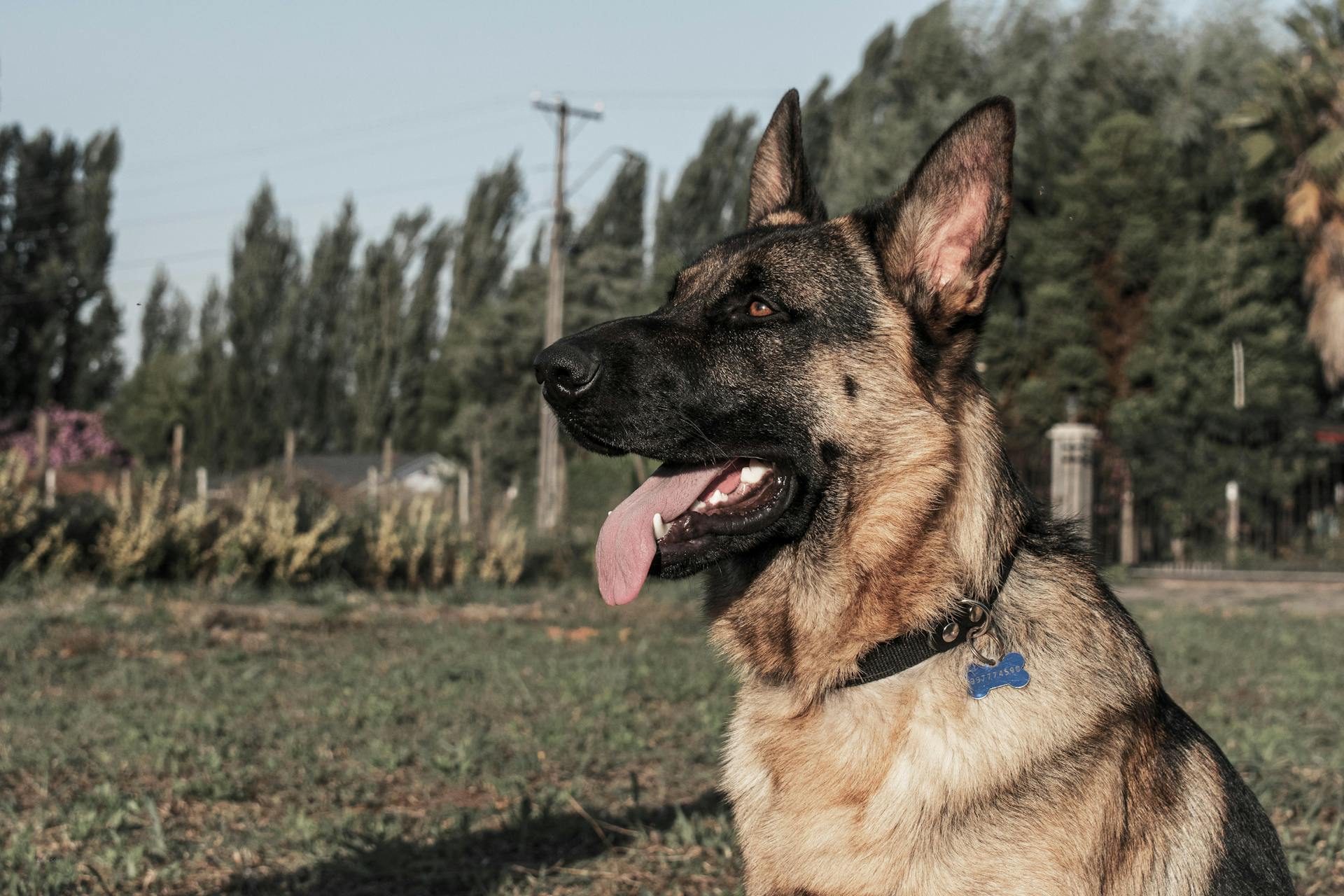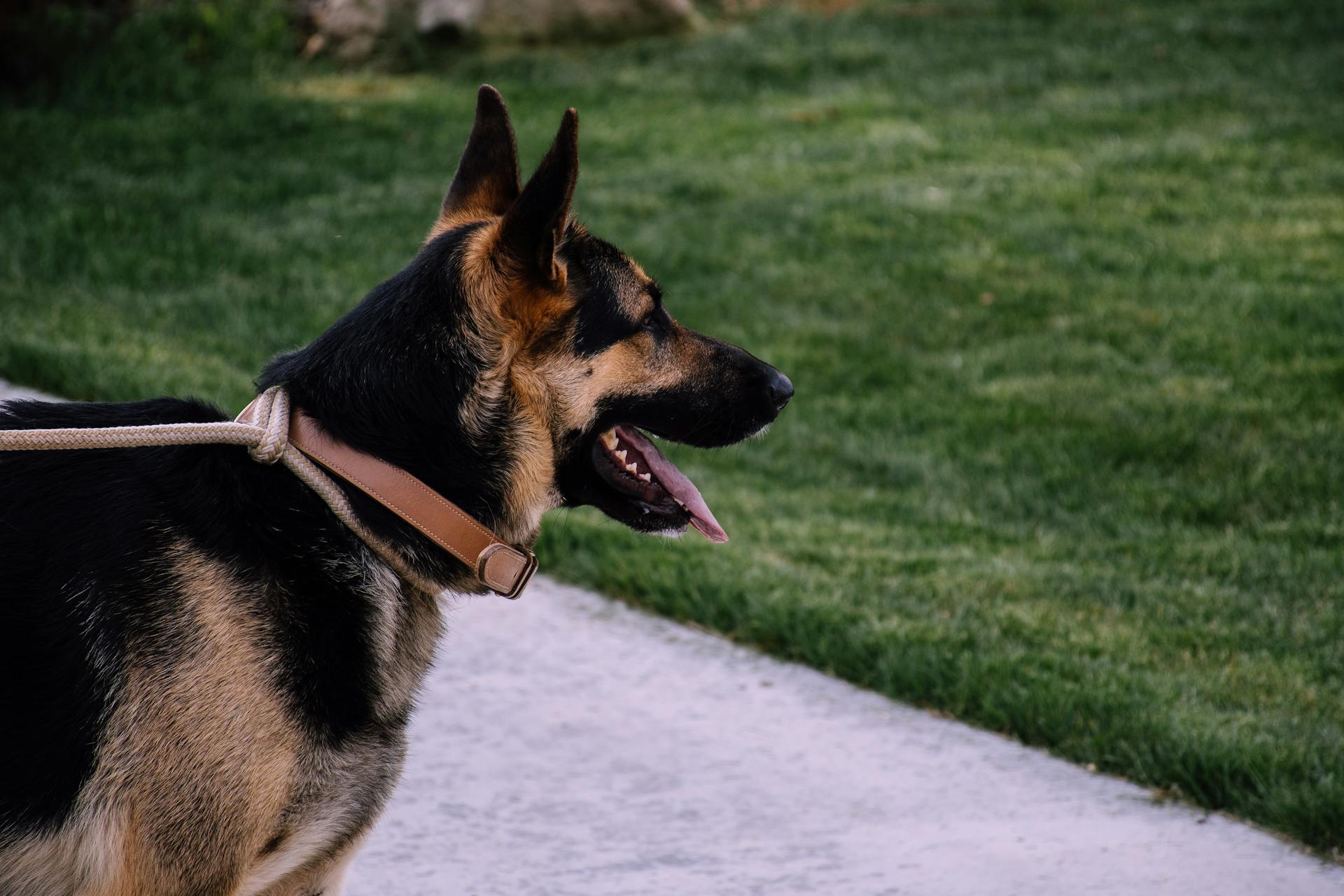
Working Line German Shepherds are bred for their exceptional intelligence, athleticism, and loyalty. They're not your average family pet, but rather a partner in various roles such as search and rescue, police work, and guiding the blind.
Their high energy levels require regular exercise and mental stimulation, making them a great fit for active owners who can provide the necessary physical and mental challenges. They thrive on structure and clear communication, which is essential for their training and development.
A well-socialized Working Line German Shepherd can grow into a confident and calm companion, but early socialization and training are crucial to preventing potential behavioral issues. With proper care and attention, they can live up to 12-14 years, making them a long-term investment for many families.
Everything You Need to Know
The German Shepherd breed has a rich history, and understanding its origins can help you appreciate the characteristics of working line German Shepherds. Originally bred in the late 19th century, the breed was created by Max von Stephanitz to produce dogs that were intelligent and strong enough to perform physically demanding jobs while maintaining a loving and loyal nature for their masters.
Working line German Shepherds have been developed over three distinct versions, including the West German Working Line, the East German/DDR Working Line, and the Czech Working Line. Each of these lines has been bred for specific purposes, such as military and police work.
One of the defining characteristics of working line German Shepherds is their physical attributes. They have stamina and agility that defies their size, making them well-suited for physically demanding tasks. While they may lack the cosmetic attributes of show dogs, they more than make up for it with their endless energy and powerfully lithe bodies.
Working line GSDs are also known for their fearless instincts, tackling situations with intelligence and confidence. This unflappable approach to work makes them invaluable in roles such as private security, police work, and high-level military use.
If you're considering bringing a working line German Shepherd into your family, be prepared for a dog with unmatched temperament. They are fiercely loyal and have exceptional energy to perform the tasks they're trained to accomplish. You won't find a smarter dog capable of being trained at the highest levels.
Here are the three distinct versions of working line German Shepherds:
Working Line German Shepherds
Working Line German Shepherds are bred with a focus on health and functionality, not just physical appearance.
They undergo rigorous health testing protocols, including evaluations for hip and elbow dysplasia, genetic disorders, and other potential health issues.
This means they are more likely to come from a lineage with a clean bill of health, reducing the risk of hereditary conditions.
Responsible breeders prioritize health and functionality over aesthetics, which is a big plus for families looking for a loyal and capable companion.
Types of Working Line German Shepherds
Working Line German Shepherds can be broadly categorized into several types, each with its unique characteristics and purposes.
The Police Line German Shepherd is bred specifically for law enforcement and military work, requiring a strong prey drive and high energy levels.
They are often used for tasks such as narcotics detection, patrol work, and search and rescue operations.
The Schutzhund Line German Shepherd is focused on protection and obedience, with an emphasis on strong guarding instincts and athletic ability.
Related reading: How Strong Are German Shepherds
This type of German Shepherd is often used for personal protection and as a family guard dog.
The DDR Line German Shepherd originated in East Germany and is known for its high intelligence and strong work ethic.
DDR Line German Shepherds are often used for tasks such as herding and guarding livestock.
The Czech Line German Shepherd is a rare and highly sought-after type, prized for its intelligence, athleticism, and strong prey drive.
Czech Line German Shepherds are often used for tasks such as tracking and hunting.
Curious to learn more? Check out: How Often Should German Shepherds Be Groomed
Health Testing Standards
Working line German Shepherd breeders prioritize health and functionality over aesthetics, subjecting their breeding stock to comprehensive health screenings.
These tests often include evaluations for hip and elbow dysplasia, genetic disorders, and other potential health issues that could affect the dog's ability to perform its intended tasks.
Reputable breeders take the time to thoroughly evaluate their breeding stock, which is a testament to their commitment to producing healthy puppies.
In contrast, some breeders may focus more on physical appearance and conformation to breed standards, sometimes at the expense of health.
Working line German Shepherds are more likely to come from a lineage with a clean bill of health, reducing the risk of hereditary conditions and ensuring that the puppies have a solid foundation for a healthy life.
Regional Origins
Working line German Shepherds originated from the Silesia region of Germany, where they were bred as herding dogs. Their ancestors were primarily German Shepherds from the 19th and early 20th centuries.
The Silesia region's unique geography and climate played a significant role in shaping the breed's characteristics. The dense forests and rugged terrain required dogs that were intelligent, agile, and highly trainable.
West
The West German Working Line German Shepherds have been referred to as the most balanced in terms of appearance, temperament, and working ability.
They were bred to excel in jobs such as protection and law enforcement, and have a strong working drive and great ability. This is in contrast to the West German Show line, which was bred to conform to specific show standards.
If this caught your attention, see: Pure Bred German Shepherds

Their bodies have been bred to take on a more defined working structure relative to the show line types, with a slight slope of their backs characterizing their appearance.
They require great attention in terms of exercise and mental stimulation due to their high working drive characteristic, and have a lot of energy that needs to be continuously occupied with high-intensity activities.
East
The East region is often associated with the rising sun and the birthplace of many ancient civilizations. The region spans across multiple continents, including Asia and Europe.
The Silk Road, a network of trade routes, connected the East to the Middle East and Europe, facilitating the exchange of goods, ideas, and cultures. This period of cultural exchange had a profound impact on the development of various societies.
The East is also home to some of the world's most populous countries, including China and India, which have made significant contributions to global cuisine, philosophy, and art.
Czech

The Czech German Shepherds originated from the communist Czech Republic in 1955, bred as working dogs. They were initially bred for border control jobs.
These dogs were later bred more as family pets after the reunification of Germany in 1989. The Czech Army managed the kennels where they were bred.
Czech German Shepherds tend to have higher drives than their East German counterparts. They are generally smaller in size, with males measuring 24″ to 26″ at the shoulder.
Females typically measure 22″ to 24″, and weigh between 49-61 pounds. Males weigh around 66 to 68 pounds.
Czech German Shepherds have a slender yet dense appearance, with a deep chest and strong jaws. They stand on thick, tight paws.
See what others are reading: Where Did German Shepherds Originally Come from
Training and Comparison
Training a working line German Shepherd requires early socialization and obedience training to develop their strong work ethic and high intelligence.
Working line German Shepherds are highly trainable, with a strong desire to please their handlers and perform tasks. They thrive on structure and clear communication.
These dogs require consistent training from an early age, with a focus on basic obedience commands and socialization with people and other animals.
Their high energy levels and strong herding instincts make them well-suited for tasks that require physical and mental stimulation, such as agility training and herding competitions.
Working line German Shepherds are often compared to other breeds, including standard German Shepherds, which are bred for conformation and companionship rather than work.
While standard German Shepherds can still be highly trainable, they may not have the same level of drive and work ethic as working line German Shepherds.
Frequently Asked Questions
Do working line German shepherds make good service dogs?
Working line German Shepherds can make excellent service dogs due to their high trainability and physical strength, making them well-suited for mobility assistance tasks. Their size and ability to pull or steady make them a popular choice for service dog work.
Do working line German shepherds have hip problems?
Yes, German Shepherds are prone to hip issues like hip dysplasia, affecting them from puppyhood to adulthood
How much is a working line German Shepherd?
The cost of a working line German Shepherd puppy typically ranges from $1,000 to $2,500, depending on the breeder and bloodlines. If you're looking for a working line German Shepherd, expect to pay less than a puppy with championship bloodlines.
Sources
- https://germanshepherdshop.com/blogs/list/the-german-shepherd-dog-working-line-vs-show-line
- https://www.debutshepherds.com/what-are-the-different-bloodlines-of-working-line-shepherds
- https://www.banffyhausgermanshepherds.com/german-shepherd-working-vs-show-lines/
- https://vomragnar.com/between-german-shepherds-dogs-show-line-vs-working-line/
- https://czechworkingline.com/german-shepherd-working-line/
Featured Images: pexels.com


